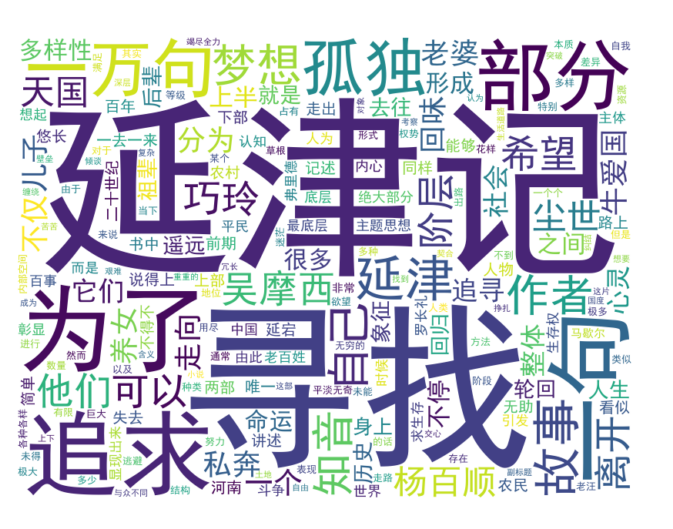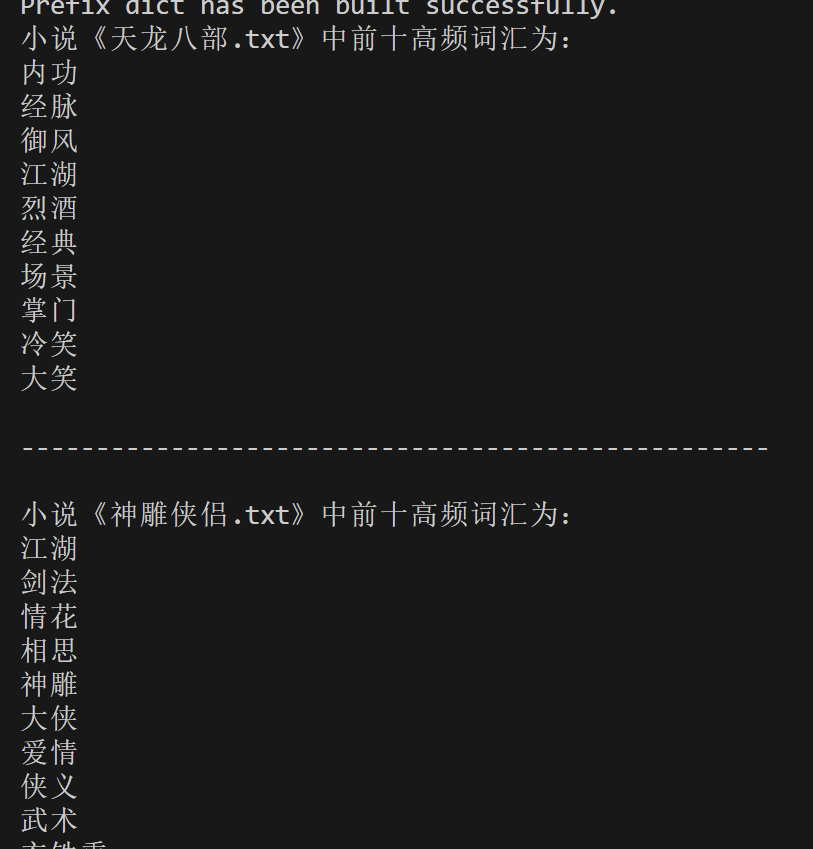目的 :熟练操作组合数据类型。
试验任务:
- 基础:生日悖论分析。如果一个房间有23 人或以上,那么至少有两
个人的生日相同的概率大于50%。编写程序,输出在不同随机样本数
量下,23 个人中至少两个人生日相同的概率。
源码:
点击查看代码
import random
def has_duplicate_birthdays():
birthdays = [random.randint(1, 365) for _ in range(23)]
return len(set(birthdays)) != len(birthdays)
def calculate_probability(sample_size):
count = 0
for _ in range(sample_size):
if has_duplicate_birthdays():
count = count + 1
return count / sample_size
#不同的随机样本数量
sample_sizes = [100, 1000, 10000, 100000]
for size in sample_sizes:
probability = calculate_probability(size)
print(f"当样本数量为 {size} 时,23 个人中至少两个人生日相同的概率为: {probability:.4f}")运行截图:

- 进阶:统计《一句顶一万句》文本中前10 高频词,生成词云。
源码:
点击查看代码
import jieba
from collections import Counter
from wordcloud import WordCloud
import matplotlib.pyplot as plt
def generate_wordcloud(file_path):
try:
# 读取文本文件
with open(file_path, 'r', encoding='utf-8') as file:
text = file.read()
# 分词
words = jieba.lcut(text)
# 过滤停用词,这里简单过滤单字和一些常见无意义符号
stopwords = set([',', '。', '、', '的', '是', '在', '和', '也', '有', '不'])
filtered_words = [word for word in words if word not in stopwords and len(word) > 1]
# 统计词频
word_counts = Counter(filtered_words)
# 获取前 10 高频词
top_10_words = word_counts.most_common(10)
print("前 10 高频词:")
for word, count in top_10_words:
print(f"{word}: {count}")
# 生成词云
wordcloud = WordCloud(font_path='simhei.ttf',
background_color='white',
width=800,
height=600).generate_from_frequencies(word_counts)
# 显示词云
plt.figure(figsize=(8, 6))
plt.imshow(wordcloud, interpolation='bilinear')
plt.axis('off')
plt.show()
except FileNotFoundError:
print(f"错误:未找到文件 {file_path},请检查文件路径是否正确。")
except Exception as e:
print(f"发生未知错误:{e}")
file_path = 'yi.txt'
generate_wordcloud(file_path)运行截图: 
- 拓展:金庸、古龙等武侠小说写作风格分析。输出不少于3 个金庸(古
龙)作品的最常用10 个词语,找到其中的相关性,总结其风格。
源码:
点击查看代码
import jieba
from collections import Counter
import re # 导入正则表达式模块
def count_word_frequencies(file_path, top_n=10):
with open(file_path, 'r', encoding='utf-8') as file:
text = file.read()
# 使用 jieba 进行分词
words = jieba.lcut(text)
# 排除一些常见的无意义词汇(停用词)
stopwords = set('的 了 是 在 和 有 个 与 不 一 我 他 以 也 子 之 幺'.split())
filtered_words = [word for word in words if word not in stopwords and len(word.strip()) > 1]
# 增加对标点符号的过滤
filtered_words = [word for word in filtered_words if not re.match(r'^[\W_]+$', word)]
# 统计词频
word_counts = Counter(filtered_words)
# 获取出现频率最高的前 top_n 个词
most_common_words = word_counts.most_common(top_n)
return most_common_words
# 调用函数并打印结果
file_paths = ['天龙八部.txt', '神雕侠侣.txt']
for file_path in file_paths:
most_common_words = count_word_frequencies(file_path, top_n=10)
print(f"小说《{file_path}》中前十高频词汇为:")
for word, count in most_common_words:
print(f"{word}")
print("\n" + "-"*50 + "\n")运行截图:

金庸作品风格为:
金庸的作品充满了中国传统文化元素,包括历史、哲学、文学、武术等。他巧妙地将这些元素融入到故事情节中,使得作品不仅是一部武侠小说,更是一部展示中华文化的窗口。金庸的作品强调善恶有报、正义终将战胜邪恶的理念。爱情是金庸小说不可或缺的一部分,他擅长描写不同类型的爱情关系------从青梅竹马到生死相依,从一见钟情到日久生情,每一种都写得动人心弦。